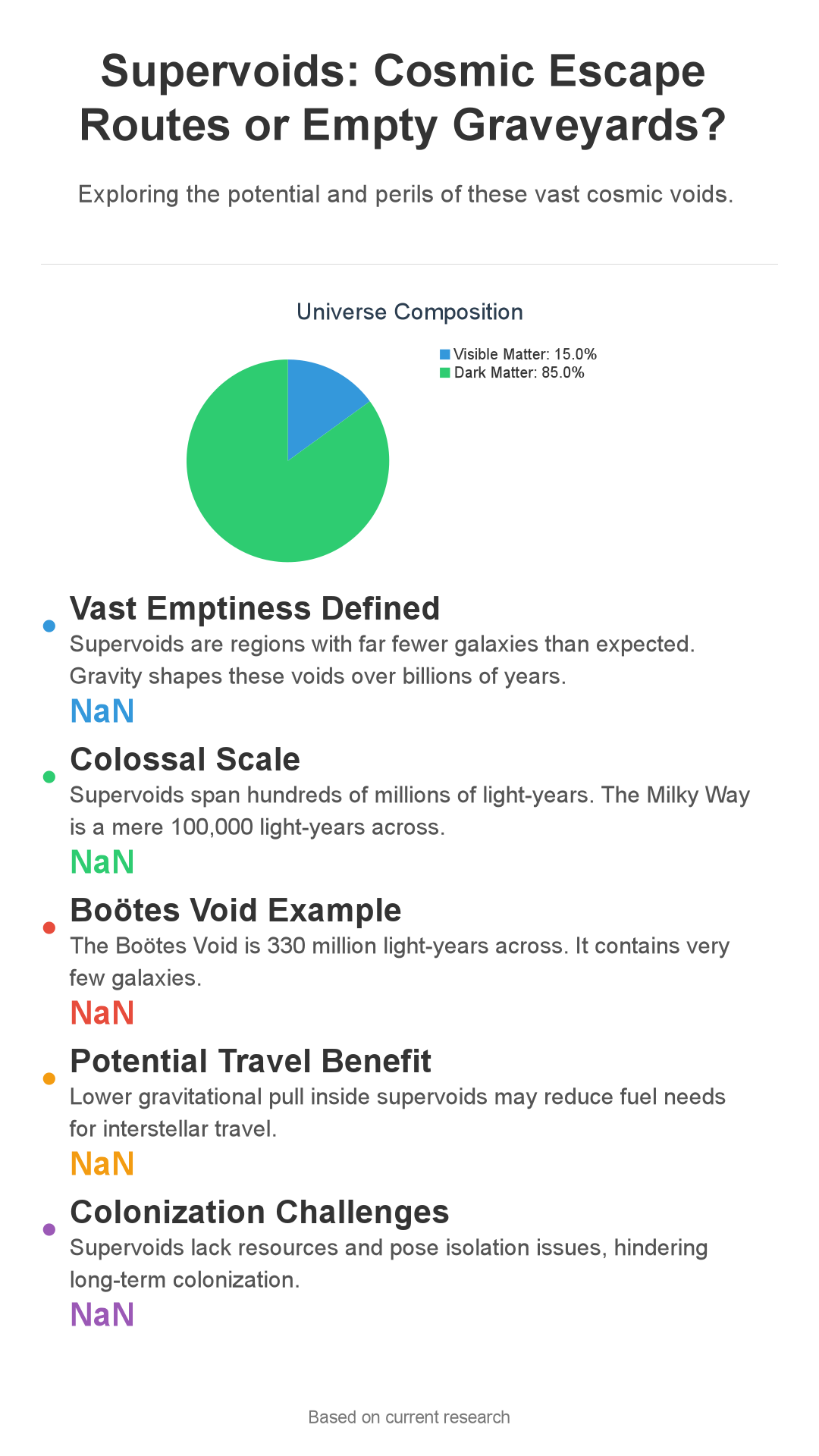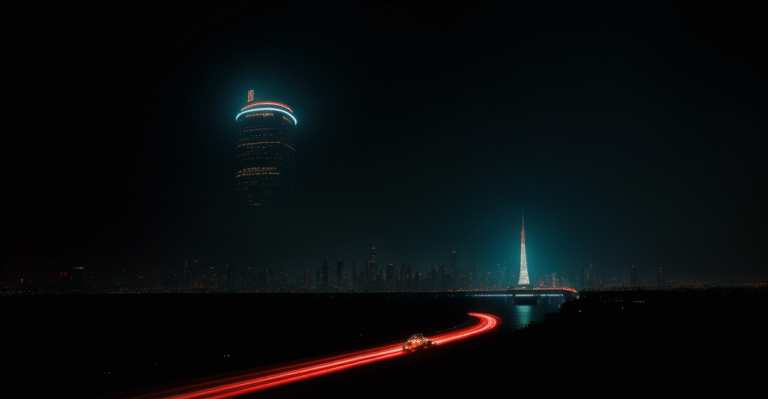
Are supervoids the key to humanity's long-term survival, or are they simply too barren to support li
Hey space explorers! Ever gaze at the stars and wonder about the *true* mysteries lurking in the cosmos? Beyond planets and nebulae lie supervoids – colossal regions of emptiness that defy imagination. Smash that like button if you’re ready to explore the universe’s strangest neighborhoods, and join us as we ask: could these cosmic voids be humanity’s future escape routes, or are they simply silent galactic graveyards?
Imagine a cosmic ocean, impossibly vast and eerily silent, where galaxies are few and far between. These are supervoids, some of the largest structures known to exist.
But are they merely cosmic curiosities, or could they hold the key to unlocking interstellar travel for humanity?
Understanding the Nature of Supervoids: Vast Emptiness
Definition and Formation: How Gravity Creates These Colossal Voids
Supervoids are more than just empty space; they are regions with significantly fewer galaxies than expected, stretching across hundreds of millions of light-years. How do these immense voids form? The leading theory points to gravity.
Over countless billions of years, gravity relentlessly pulls matter together, creating dense regions like galaxy clusters and, conversely, leaving behind vast, underdense areas – the supervoids.
Size and Distribution: Comparing Supervoids to Other Cosmic Structures
These voids are truly colossal. To give you a sense of scale, our own Milky Way galaxy is about 100,000 light-years across. Supervoids can span hundreds of *millions* of light-years in diameter!
They aren’t scattered randomly; they form part of the cosmic web, an immense network of filaments, sheets, and voids that constitutes the large-scale structure of the universe.
The Boötes Void: A Prime Example and Its Unique Characteristics
The Boötes void, also known as the Great Void, stands out as one of the most well-known and extensively studied supervoids. Located in the constellation Boötes, it’s estimated to be a staggering 330 million light-years across.
Compared to what would normally be expected in a region of that size, it contains only a scattering of galaxies.
This makes it an invaluable target for astronomers investigating galaxy formation and evolution, as well as the distribution of dark matter.
Supervoids as Potential “Escape Pods”: Benefits for Interstellar Travel
Reduced Gravitational Pull: Lower Fuel Requirements for Traversing Voids
One of the most compelling ideas is the potential of using supervoids as cosmic shortcuts. Due to their extremely low matter density, the gravitational pull within them is significantly weaker than in regions brimming with galaxies.
This means that spacecraft traversing a supervoid would experience less gravitational drag, potentially leading to substantial fuel savings on interstellar journeys.
Lower Density of Cosmic Hazards: Decreased Risk of Collisions with Asteroids or Rogue Planets
Space is fraught with hazards: asteroids, rogue planets drifting through the void, and clouds of cosmic dust. However, supervoids, by their very nature, exhibit a much lower density of these potentially dangerous objects.
This translates to a reduced risk of collisions, making them potentially safer pathways for interstellar travel.
Less Radiation Exposure: Shielding Requirements Potentially Lessened in These Regions
Radiation poses a significant threat to long-duration space travel. Cosmic rays and other forms of radiation can damage spacecraft systems and pose serious health risks to astronauts.
While supervoids aren’t entirely radiation-free, the lower density of matter suggests that less shielding might be required, reducing the overall weight and cost of spacecraft.
[IMAGE: A comparison of radiation levels in a galaxy cluster vs.
Supervoids: A Harsh Environment for Colonization
Lack of Resources: Scarce Availability of Raw Materials for Building Infrastructure
While supervoids might offer advantages for getting from one star system to another, they present formidable challenges for long-term colonization. The scarcity of galaxies directly translates to a scarcity of readily accessible resources.
Constructing infrastructure, mining for raw materials, and even producing food would be exceptionally difficult in such an environment.
Isolation and Distance: Communication and Travel Challenges To and From Populated Areas
Even if we could overcome the resource limitations, the profound isolation of supervoids presents another major obstacle.
Communication with Earth or other colonies would be plagued by delays of hundreds of millions of years due to the immense distances involved. Travel to and from populated areas would also be incredibly time-consuming and prohibitively expensive.
Potential Physiological Effects: Impact of Long-Term Isolation on Human Psychology
Speaking of psychology, prolonged isolation can have devastating consequences on the human mind. Studies on astronauts in isolated environments have revealed increased rates of depression, anxiety, and cognitive decline.
Now, imagine spending your entire life within a supervoid, with minimal contact with the outside world.
The Dark Matter Enigma Within Supervoids
The Expected vs. Observed Dark Matter Distribution in Voids
Dark matter, the mysterious substance that constitutes about 85% of the universe’s mass, plays a pivotal role in galaxy formation.
Scientists anticipate finding *some* dark matter within supervoids, even if its density is lower than in other regions. However, observations suggest that the distribution of dark matter in voids might deviate from our theoretical predictions.
Implications for Our Understanding of Dark Matter’s Role in Galaxy Formation
If supervoids indeed contain less dark matter than expected, it could have profound implications for our understanding of how galaxies form. Dark matter is believed to provide the gravitational scaffolding around which galaxies coalesce.
If voids lack this scaffolding, it could potentially explain why they are so sparsely populated.
How Researching Supervoids May Unlock Secrets of Dark Matter
Studying supervoids offers an unparalleled opportunity to probe the very nature of dark matter.
By carefully analyzing the distribution of galaxies and the cosmic microwave background radiation within and around these voids, scientists can gain valuable insights into the properties of dark matter and its role in the evolution of the universe.
So, are supervoids destined to be humanity’s future escape pods or desolate galactic graveyards? The answer, as with most things in the universe, is complex and nuanced.
They offer the tantalizing prospect of faster, safer interstellar travel, but also present daunting challenges for long-term colonization.
Now it’s your turn to weigh in! If humanity *were* to embark on a journey into a supervoid, what do you believe would be the single biggest obstacle to overcome?
And what specific technologies or innovations would be absolutely essential to make such a venture feasible?
If you enjoyed this cosmic exploration, be sure to subscribe for more in-depth dives into the universe’s grandest mysteries!

Enjoyed this? Check out our YouTube channel for video versions!
Enjoyed this? Check out our YouTube channel for video versions!



